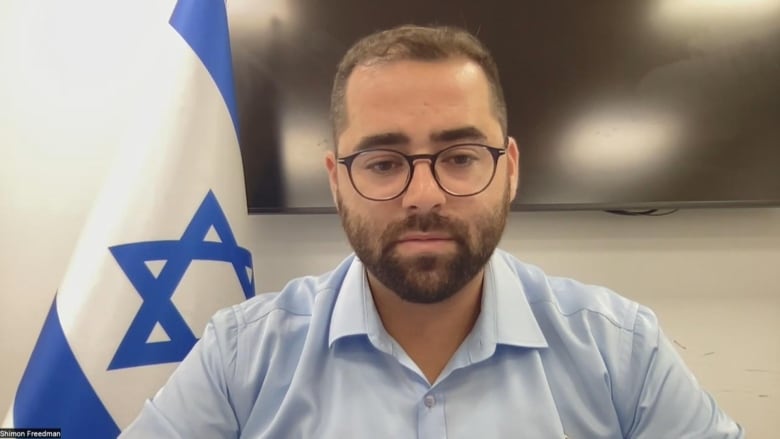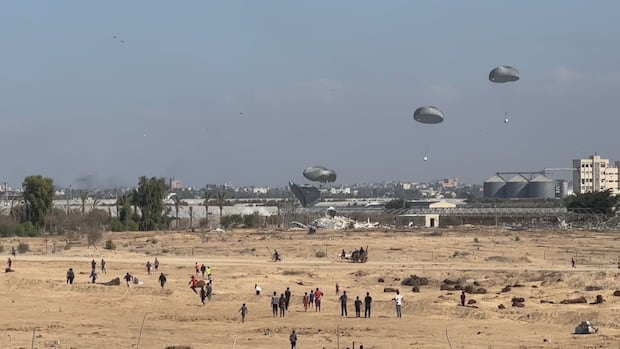An Israeli government agency tasked with co-ordinating aid deliveries to Gaza is rejecting figures reported by international organizations on the number of supply trucks entering the war-torn enclave, a day after Israel failed to meet the United States’ deadline to allow in more humanitarian assistance.
Shimon Friedman, a spokesperson for the agency, said COGAT oversees and co-ordinates with each aid truck entering any of the five crossings into the Gaza Strip, including the Kissufim crossing that opened Tuesday.
“The only organization really with a full view of what is coming into the Gaza Strip is COGAT, and the numbers are not what they are representing,” he told CBC News Wednesday, referring to international organizations.
Instead, Friedman placed the blame on those same organizations, saying they aren’t “doing enough to pick up that aid and distribute it.”
The search for food in Gaza has grown more difficult as the Israel-Hamas war drags on, and as the potential for famine sets in, the rush toward aid packages dropped from planes can potentially be lethal. One man told a freelance videographer for CBC News that there are families sheltering in the fields where some drops happen, and if boxes land nearby, they are claimed and those families will shoot anyone who comes near them.
The Biden administration had set a minimum requirement of 350 supply trucks being allowed entry into Gaza each day, something that a 19-page report published Tuesday by eight aid groups, including Oxfam, Save the Children and the Norwegian Refugee Council, alleges Israel has failed to do.
The report said just over 1,000 total trucks had crossed into Gaza, an average of just 42 trucks a day, according to figures reported during the last week of the 30-day U.S. review period, which ended on Tuesday.
Israel says more aid trucks entering Gaza
But Friedman denied the figures, saying COGAT sees around 50 trucks entering the north and between 100 to 150 trucks entering the southern enclave each day. He told CBC News that there are between 700 and 900 aid trucks waiting on the Gazan side of the Kerem Shalom border crossing.
“That means aid that has come in through Israel, gone through security inspection,” he said. “The international organizations need to pick it up and distribute it — and it’s just sitting there.”
He noted that Israel has placed restrictions on closed trucks entering Gaza, asking international groups to use “open” trucks and accusing Hamas and other militant groups of using closed trucks to move people rather than supplies.
COGAT said humanitarian organizations involved in the report had not co-ordinated with, or sought information from, the military before filing the report and thus had produced a conclusion based on “partial information.”
The U.S. deadline expired just days after global food security experts said there was a “strong likelihood that famine is imminent” in parts of northern Gaza.
“Israel not only failed to meet the U.S. criteria that would indicate support to the humanitarian response, but concurrently took actions that dramatically worsened the situation on the ground, particularly in northern Gaza,” aid groups said in the Tuesday report. “That situation is in an even more dire state today than a month ago.”

The IDF rejected that assertion as it pressed its military offensive against Hamas militants in the area. It said Tuesday it had allowed hundreds of packages of food and water into Jabalia and Beit Hanoun, two areas under siege in the far north of Gaza. The Palestinian civil defence agency said three trucks carrying flour, canned food and water reached Beit Hanoun.
It was only the second delivery allowed into the area since the beginning of October. A smaller shipment was let in last week, though not all of it reached shelters in the north, according to the UN.
International aid groups say Israel has failed to meet a series of U.S. demands intended to improve the humanitarian crisis in Gaza by a Tuesday deadline. The U.S. said Israel could face restrictions on military aid if it did not improve the aid situation in Gaza.
Ceasefire efforts stall
Efforts by Arab mediators, Qatar and Egypt, backed by the United States, have so far failed to end the war in Gaza, with Hamas and Israel trading the blame for the lack of progress.
Speaking on Wednesday, U.S. Secretary of State Antony Blinken said Israel “has accomplished the goals that it set for itself” by taking out Hamas’s leadership and ensuring the group is unable to launch another massive attack. “This should be a time to end the war,” he said.
“We also need to make sure we have a plan for what follows,” he said, “so that if Israel decides to end the war and we find a way to get the hostages out, we also have a clear plan so that Israel can get out of Gaza and we make sure that Hamas is not going back in.”
Meanwhile, Israeli military strikes killed at least 22 Palestinians across the Gaza Strip on Wednesday, as Israeli forces deepened their incursion into Beit Hanoun town in the north, forcing most remaining residents to leave.
Residents said Israeli forces besieged shelters housing displaced families and the remaining population, which some estimated at a few thousand, ordering them to head south through a checkpoint separating two towns and a refugee camp in the north from Gaza City.
Men were held for questioning, while women and children were allowed to continue toward Gaza City, residents and Palestinian medics said.
Northern Gaza incursion deepens
Israel’s campaign in the north of Gaza, and the evacuation of tens of thousands of Palestinians from the area, has fuelled claims from Palestinians that it is clearing the area for use as a buffer zone and potentially for a return of Jewish settlers.
“The scenes of the 1948 catastrophe are being repeated. Israel is repeating its massacres, displacement and destruction,” said Saed, 48, a resident of Beit Lahiya, who arrived in Gaza City on Wednesday.
“North Gaza is being turned into a large buffer zone, Israel is carrying out ethnic cleansing under the sight and hearing of the impotent world,” he told Reuters via a chat app.
Saed was referring to the 1948 Middle East Arab-Israeli war which gave birth to the state of Israel and saw the displacement of hundreds of thousands of Palestinians from their home towns and villages in what is now Israel.
The Israeli military has denied any such intention, and Prime Minister Benjamin Netanyahu has said he does not want to reverse the 2005 withdrawal of settlers from Gaza. Hardliners in his government have talked openly about going back.
It said forces have killed hundreds of Hamas militants in Jabalia, Beit Lahiya and Beit Hanoun during its new military offensive, which began more than a month ago. Hamas and the Islamic Jihad armed wing claimed killing several Israeli soldiers during ambushes and anti-tank rocket fire.
Attacks across Gaza Strip continue
Medics said five people were killed in an Israeli strike that hit a group of people outside Kamal Adwan Hospital near Beit Lahiya, while five others were killed in two separate strikes in Nuseirat in central Gaza Strip where the army began a limited raid two days ago.
In Rafah, near the border with Egypt, one man was killed and several others were wounded in an Israeli airstrike, while three Palestinians were killed in two separate Israeli airstrikes in Shejaia suburb of Gaza City, medics added.
Later on Wednesday, an Israeli strike on a house in western Khan Younis in the southern Gaza Strip killed eight people, medics said.
Hamas-led gunmen attacked Israel last October, killing some 1,200 people and taking more than 250 hostages, according to Israeli tallies.
More than 43,500 Palestinians have been killed in Gaza over the past year, Palestinian health officials say, and much of Gaza has been reduced to a wasteland of wrecked buildings and piles of rubble, where more than two million Gazans are seeking shelter in makeshift tents and facing shortages of food and medicines.



